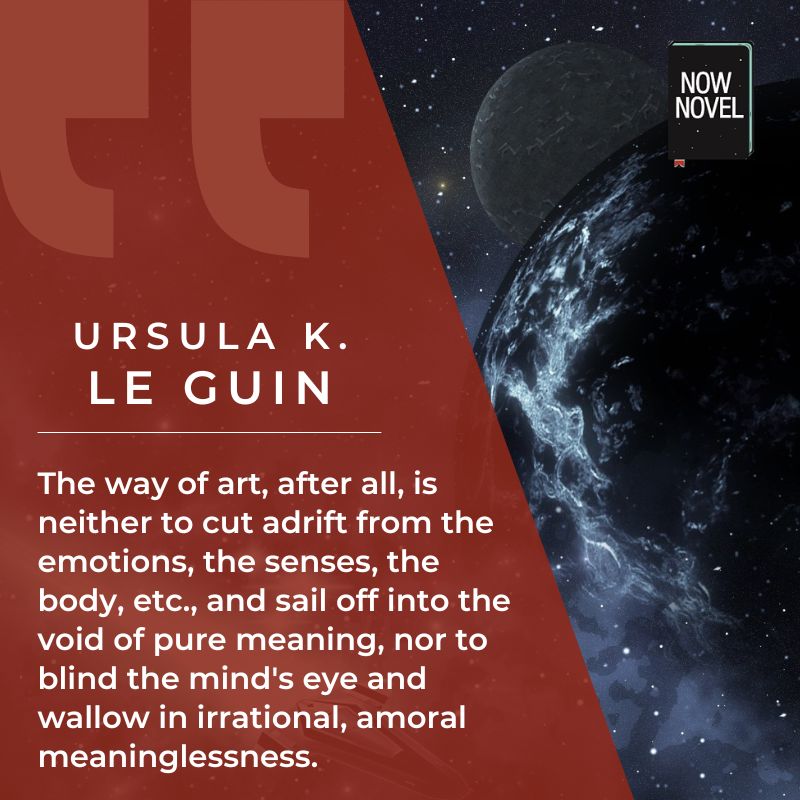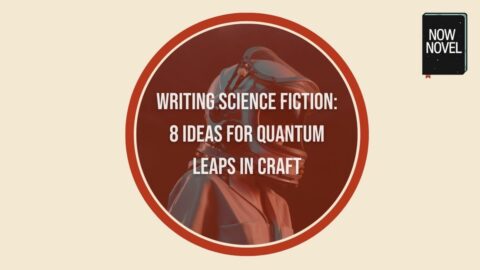Writing science fiction has many pitfalls. Jargon-filled language; cryptic abstraction. Read eight tips and ideas from sci-fi icons, from advice on learning the basics to the power of speculation, plus more:
Sci-fi writing tips and ideas from icons of the genre
What tips and ideas do sci-fi greats offer?
- Learn the nuts and bolts first.
In an interview for Dragon Con, Anne McCaffrey gives this simple advice: ‘Learn how to spell, use grammar and syntax. What makes you think you can drive without the fuel.’
- Make the improbable seem possible.
Rod Serling, Emmy-winning screenwriter and creator of the sci-fi anthology series The Twilight Zone, said ‘Science fiction is the improbable made possible.’ How will you add the real?
- Balance abstract, big ideas with sensory description.
Ursula K. Le Guin, in ‘Myth and Archetype in Science Fiction’, reminds us that sci-fi shouldn’t be over-intellectualized. Readers want emotive and sensory substance, too.
- Gather surplus material to shape later.
This advice comes from a note comic sci-fi legend Douglas Adams wrote himself. Read the article for the full quote.
- Discern possibilities and offer warnings.
Octavia E. Butler suggests that predicting possible futures also means to ‘learn from the past’ and its warnings for the future.
- Use any techniques your science fiction needs.
Sci-fi author NK Jemisin talks about using literary techniques or devices from fantasy in her science fiction and of being open to using whatever devices her story dictates.
- Explore thinking about space and time.
Space and time are two of science’s primary dimensions. Arthur C. Clarke’s The Exploration of Space predicted many modern technological developments. Stay curious like Clarke or Galileo.
- Draw upon rough and ready sci-fi inspiration.
Lois McMaster Bujold responded to a fan’s question about her fictional setting Tripoint that it was inspired by her parents’ hometown, calling it ‘rough and ready inspiration.’ Try that.
Let’s explore these sci-fi insights further:
Learn the nuts and bolts first
Anne McCaffrey, author of the ‘Dragonriders of Pern’ science fiction series, was the first woman to win the prestigious Hugo and Nebula science fiction awards.
McCaffrey’s advice, to learn the basics (including how to spell and use syntax and grammar) applies not only to writing science fiction but all writing genres.
The author’s advice applies to understanding genre, too. It is wise to read widely within your own, and without. One benefit of building a broader knowledge of the sci-fi genre is knowing its social and political history and possibilities.
For example, McCaffrey explains concisely why there were many more men writing sci-fi than women earlier in the 20th Century:
About the time Star Trek became popular in 1968, more women began reading and writing science fiction and demanded real women heroes. Star Wars and ET also brought more female fans into the fantasy and science fiction areas. It used to be that girls were kept out of the sciences because they were expected to be wives and mothers and so on.
Anne McCaffrey, interviewed by Sara McCorkendale ‘Be Careful What You Wish For, You May Get It!’, DragonCon, July 4, 1999.
Make the improbable seem possible
Writing science fiction, like writing fantasy stories, is speculative. What does that mean? That it is a genre based as much in conjecture and hypothesis as fact.
It is not a known fact, for example, that in the year 2100 AI-based robots will be in-home companions and caretakers for humans. Yet taking this scenario as the departure point for a ‘what if’ story is the kind of game science fiction plays. It’s quite possible, given major leaps in robotics and AI in the past twenty years.
Rod Serling, writer and creator of The Twilight Zone (a long-running fantasy sci-fi anthology series) said that science fiction ‘is the improbable made possible.’ [Ed’s note: Quoted by Rachel Cordasco in ‘Speculative Fiction, Translation, and Transformation’, 2022].
How do you make life on other planets or in other worlds and future technological societies seem plausible? To write science fiction that reads as plausible:
- Study human and scientific history. The past has so many lessons on how and why societies and technologies develop (or fall). See the section on Arthur C. Clarke below for more on why curiosity matters.
- Draw from life. In interviews collected on the author’s fan-run site, the late Philip K. Dick talks about immortalizing friends in the cadences of his characters. Here’s another weird real-life sci-fi story about the loss of an android PKD.
- Deduce from fact, concoct using imagination. We know what temperature and chemical conditions were necessary for life to evolve on earth. From factual knowledge, it’s not too hard to invent or deduce other systems following similar but different trajectories.

GET YOUR FREE GUIDE TO SCENE STRUCTURE
Read a guide to writing scenes with purpose that move your story forward.
Learn moreBalance abstract, big ideas with sensory description
In the excellent essay ‘Myth and Archetype in Science Fiction’, Ursula K. Le Guin writes about the dangers of academic study. How it may lead novice writers to overintellectualize craft. Says Le Guin:
In many college English courses the words “myth” and “symbol” are given a tremendous charge of significance. You just ain’t no good unless you can see a symbol hiding, like a scared gerbil, under every page.
Ursula K. Le Guin, ‘Myth and Archetype in Science Fiction’ in The Language of the Night: Essays on Fantasy and Science Fiction, (p. 75).
Le Guin continues to critique writing that only nods to the surface features of sci-fi; how that may lead to showy writing full of ’empty pomposity’:
So they [misguided writers] use mythology in an arrogant fashion, rationalizing it, condescending to it. They take plots and characters from it, not in the healthy furtive fashion of the literary sneakthief, but in a posturing, showy way. Such use of myth does real disservice to the original, by trivializing it, and no good at all to the story. The shallowness of its origin is often betrayed either by an elaborate vocabulary and ostentatiously cryptic style, or by a kind of jocose, chatty discomfort in the tone.
Le Guin, ‘Myth and Archetype in Science Fiction’, p. 76, emphasis added.
How do you avoid the trap of ostentation, forcedly cryptic style?
- Try using simple language to express complex topics. Cut jargon and balance the cryptic elements of your science fiction writing with clearer, more direct style
- Use the senses and emotions. Write for readers who have bodies, senses, emotions, and like the same in their characters
- Draw on biological metaphors. When we chatted to sci-fi author Kate Baucherel, we discussed how her work (and tech language generally) uses nature-derived metaphors to anchor and explain tech concepts (e.g. computer ‘viruses’ and ‘worms’). Extend those metaphors
As Le Guin says:
The way of art, after all, is neither to cut adrift from the emotions, the senses, the body, etc., and sail off into the void of pure meaning, nor to blind the mind’s eye and wallow in irrational, amoral meaninglessness.
Le Guin, ‘Myth and Archetype’, p. 78.
Gather surplus material to shape later
Writing science fiction may require research, yet it is important to balance thinking with action, getting words on the page.
Sci-fi author Douglas Adams wrote a note to himself (quoted by Emily Temple for Literary Hub) that reads:
It’s better to have pages and pages of material to work with and off and maybe find an unexpected shape in that you can then craft and put to good use, rather than one manically reworked paragraph or sentence.
Douglas Adams, quoted in ‘Read Douglas Adams’s advice to writers who hate writing’ by Emily Temple, Literary Hub. March 22, 2021.
Writing from the gut, throwing out ideas, is a valid approach. You can always edit a ‘bad’ page.
See Now Novel’s complete guide to the writing process for ways to make the writing process work for you, not against you.
Discern possibilities and warnings
We’ve read what not to do in writing science fiction (mimic aesthetics without substance; use a style of shallowness and pomp). So what can you do to bring substance to the genre’s blend of fantasy and imagination?
Acclaimed sci-fi author Octavia E. Butler describes the work of the science fiction writer in terms of inquiry and finding hope. Discerning possibilities and offering warnings. Action and change depend on awareness and deeper understanding.
Given current, past or imagined laws, scientific thought, human (and non-human) social, political and technological development, what other realities become possible?
The very act of trying to look ahead to discern possibilities and offer warnings is in itself an act of hope.
Octavia E. Butler, ‘A Few Rules for Predicting the Future’, Common Good Collective (originally published in Essence magazine, 2000).
In this same piece, Butler talks about the imperative to ‘learn from the past’. Creating worlds, civilizations and futures means understanding ’empire and ashes’:
Of course, writing novels about the future doesn’t give me any special ability to foretell the future. But it does encourage me to use our past and present behaviors as guides to the kind of world we seem to be creating. The past, for example, is filled with repeating cycles of strength and weakness, wisdom and stupidity, empire and ashes.
Octavia E. Butler, 2000.

Use any techniques your science fiction needs
Science fiction author NK Jemison, in conversation with Abigail Bereola, talks about the necessity of writing in your genre in your style and on your terms:
Maybe because I am a black woman, there is an automatic assumption that I am somewhere in the margins of science fiction […] But the Broken Earth series has gotten the attention that it has in part because I tend to use literary techniques as well. And that’s just because I don’t care. I’ll use whatever techniques are necessary to get the story across and I read pretty widely. So when people kept saying second person is just not done in science fiction, I was like, well, they said first person wasn’t done in fantasy and I did that with my first novel.
NK Jemisin, ‘A True Utopia: An Interview With N. K. Jemisin’, in The Paris Review, December 3, 2018.
Some genres, of course, carry strong reader expectations. You’re not going to give a Romeo and Juliet ending to feel-good romance. Yet writing science fiction offers many hybrid forms. The blending of scientific and speculative elements with other genres is common in subgenres such as:
- science fantasy – blending elements of the fantasy and SF genres
- alternate history – ‘alternate timeline’ treatments of historical scenarios, such as Philip K Dick’s novel where Nazi Germany wins WWII (The Man in the High Castle, 1962)
- steampunk – blending the retro and the futuristic, such as robots and 19th century steam-powered tech
- slipstream – genre-bending fiction borrowing from literary and sci-fi traditions. Ryan Britt charts the term’s history for Electric Literature
Explore thinking about space and time
The above reminds us that science fiction isn’t one, totemic thing. It isn’t all Wagner playing in the background as the sun rises over a distant planet.
What do great science fiction writers share, then? Curiosity. Fascination with tech, time and change. Like the scientist, the author researches and conducts thought experiments, to uncover other possibilities.
The science fiction author Arthur C. Clarke was a polymath – a sci-fi writer, science writer, futurist, undersea explorer and more. This exploratory spirit fills his non-fiction writing (which predicted many modern scientific developments).
For example, in The Exploration of Space (which predicted developments such as telecommunications satellites), he writes:
It is hard for us to imagine astronomy as it was in the days when all observations had to be made with the naked eye. We now take the telescope for granted, but it is little more than 300 years since Galileo pointed his first crude instruments at the stars.
Arthur C. Clarke, ‘The Shaping of the Dream’, in The Exploration of Space (1951).
What is hard to imagine today? Imagine that and make the improbable possible.

Draw upon rough and ready sci-fi inspiration
Science fiction writing allows ‘just-in-time’ worldbuilding. That is sci-fi and fantasy author Lois McMaster Bujold’s approach.
In response to a fan’s question asking whether Pittsburgh was the inspiration for one of her settings, Bujold replied:
In the rough & ready sort of way I’m taking inspiration from Midwestern American rather than the bog-standard European models for fantasy worlds, yep, Pittsburgh. (My parents’ hometown, btw.)
Lois McMaster Bujold, via author’s Goodreads page.
Even the most intergalactic, fantastical stories have their roots in the real. The towns, faces, voices you know. You don’t need to be a nuclear physicist to write sci-fi about intergalactic nuclear war (or peace-keeping missions).
Research what you need to start writing, and improvise the rest, with the exploratory spirit of Galileo.
Whether you’re writing science fiction or another genre, kickstart your novel with Now Novel’s six-week course and get feedback on your first three chapters as you create a foolproof plan to finish.
🗣️ What do you love about science fiction? Who are some of your favorite SF authors? Share in the comments!
Sci-fi writing FAQ
Science fiction (shortened as SF or sci-fi often) is a broad genre that speculates on current and future science and technology. Common themes and subjects include space travel, non-human intelligences, the dangers in technological progress without firm ethical frameworks, and more.
The biggest publishers include Tor Books, Gollancz, Orbit Books (a division of Lagardère Publishing), Ace Books, and Bantam Spectra (an imprint of Bantam Books which is owned by Random House). Reedsy offers this list of 63 sci-fi publishers.




2 replies on “Writing science fiction: 8 ideas for quantum leaps in craft”
What do I love about SF? In fantasy, you can get lost in a world that will never be, and that can be freeing. In science fiction, however, there’s an undertone of “could be” that you can feel in your toes. It makes the words on the page just a bit more real. Maybe this is why some of Lois McMaster Bujold’s work hit me so hard, and maybe it’s why I should delve deeper into some of the other greats you mentioned 😊
It’s good to get your thoughts, Margriet!
Yes there’s certainly an undertone of ‘could be’.
Glad you found the post useful. Happy reading!